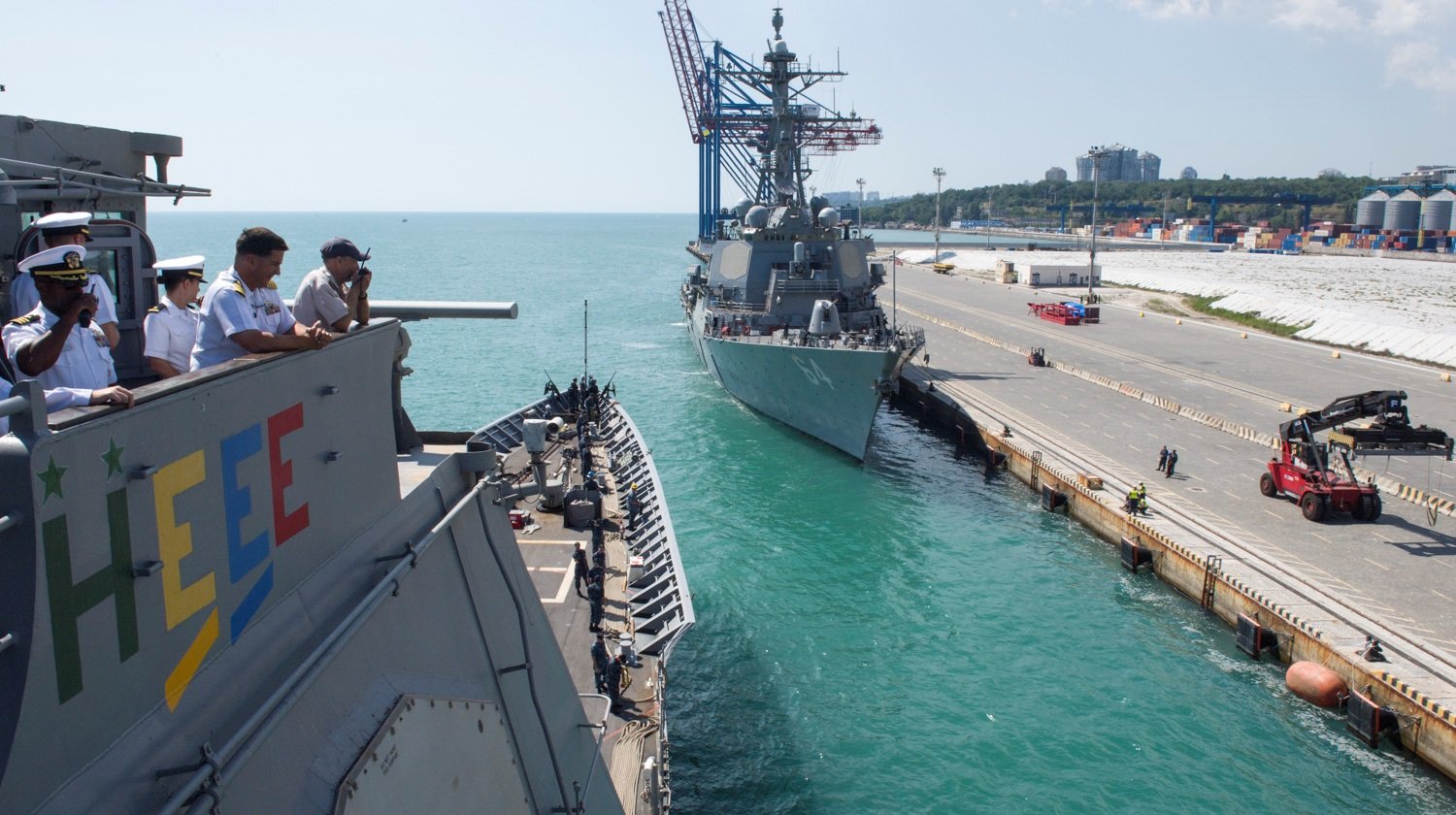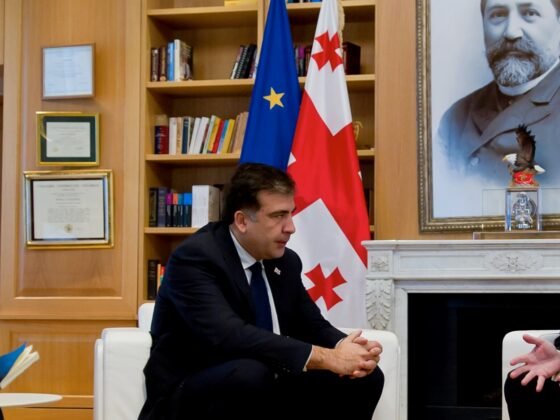(PONARS Eurasia Policy Memo) The strengthening of Ukraine’s naval capabilities in the Black Sea is taking place in line with the growing U.S. understanding of the need to contain Russia at sea. Ukraine’s new Naval Doctrine implies building up its naval potential to the level of the Russian Black Sea Fleet, with the tactical goal of ensuring freedom of navigation for Ukrainian ships and the strategic goal of restoring the territorial integrity of Ukraine over Crimea. As for NATO, a militarily strong Ukraine will help contain Russia in the Black Sea without the organization’s direct involvement. Kyiv would be shrewd to be at the forefront of this containment strategy, preventing Moscow from transforming the Black Sea’s gray zones into Russian mainstays. However, strengthening the capacity of the Ukrainian Navy in the Black Sea creates a security dilemma. In response to the consolidation and improvement of Ukrainian naval capabilities, Russia plans to bolster Crimea’s military potential further, which could cause escalation in eastern Ukraine.
The Black Sea’s Gray Zones
The Black Sea is frequently referred to as one of four Russian maritime theaters. The so-called “arc of steel“ maritime power projection toward Europe is built around Russia’s anti-access and area-denial (A2/AD) capabilities in the Arctic, Baltic Sea, Black Sea, and Mediterranean Sea. The Crimean peninsula, annexed by Russia, its territorial waters and exclusive economic zone (EEZ), compose the core area for Russia’s A2/AD capability in the Black Sea.
In 2020, the Crimea issue returned to Ukraine’s foreign and security policy. The establishment of the Crimea Platform, with its strategic goal of the de-occupation of Crimea, is intended to “correct the mistakes made in 2014, when the reintegration format was established for Donbas, but not for Crimea.” Closely linked with the Crimea Platform, Kyiv has intensified its efforts to reequip the Ukrainian Navy, which is based in Odessa and Mykolaiv. On June 23, 2021, a memorandum on the rearmament of the navy was signed by the government of Ukraine and the UK’s Rosyth Royal Dockyard Ltd. In total, Kyiv will receive a £1.25 billion loan ($1.7 billion) from the UK to boost its naval capabilities.
The unfreezing of the Russian-Ukrainian conflict in the Black Sea is linked to Kyiv’s intentions to freeze the conflict in eastern Ukraine. The Ukrainian authorities have lost faith in the possibility of a quick resolution of the conflict in eastern Ukraine, where Russia is taking tactical advantage of that area’s gray conflict. Moreover, according to research conducted by the Democratic Initiatives Foundation, the reintegration of the self-proclaimed Donetsk People’s republic (DPR) and Luhansk People’s Republic (LPR) under the Minsk Agreement does not enjoy much support from the Ukrainian population or from its elites. There are expectations that the gray zone of the Black Sea, in contrast to the gray zone of Donbas, can give more advantages to the Ukrainian side.
Before the assessment of opportunities for Ukraine in the Black Sea, we need to examine the international legal regulations of the waters in question. The ongoing territorial dispute between Russia and Ukraine, caused by the annexation of Crimea, has constructed several overlapping and conflicting sets of rules in the coastal waters surrounding the Peninsula. The sets of rules include 1) the status quo contested by Russia, 2) a new order backed by Russia, and 3) a de facto regime comprising what perfectly matches the notion of a “maritime gray zone.”
The Knotty Status of Crimea
The contested status quo (the regime of Ukrainian coastal waters before Crimea’s annexation) contains several gaps due to unsettled post-Soviet disputes between Russia and Ukraine. The boundaries between Russian and Ukrainian EEZs in the Black Sea, as well as in the Azov Sea, have never been settled. In the absence of clear legal regulations, everyday situations are resolved by the usage of informal norms and horizontal arrangements between Ukrainian and Russian authorities, a practice that has become the new norm after the annexation. For example, passage to the Sea of Azov and the ports in the Kerch Strait are conducted through the Kerch-Enical Channel, which demands piloting; vessel traffic service (VTS) terms and conditions apply. Before the annexation of Crimea in 2014, the Kerch Merchant Port, which belonged to Ukraine, was responsible for the VTS. But currently, VTS is provided for Ukrainian ships by the Russian authorities, which the Ukrainian side has informally agreed to respect just to keep the Mariupol and the Berdyansk seaports operational.
The second set of rules (an alleged “new regime”) is constructed by Russia’s claims on territorial waters and the EEZ of the annexed Crimea. Although Russia’s claims are illegal from the position of international law, they are supported and enforced by its military power. However, there is a lack of clarity on the practical application of Russia’s claims.
Even considering the Russian official position that “Crimea is a subject beyond the scope of any potential discussion,” the Crimean coastal waters are not, in any scenario. The configuration and distance between coastlines of mainland Ukraine and the Crimean Peninsula make it impossible for Russia to set boundaries of any claimed EEZ unilaterally, without arrangements with Ukraine, as provided by Articles 74 and 83 (UNCLOS 1982).
Finally, the third set of rules is related to the “de facto regime” in the coastal waters. This regime is a result of fluctuating interactions among Russia, Ukraine, and NATO member states, applying enforcement actions upon the status of respective maritime areas. From a de facto regime framework, Russia goes much further than the territorial waters and EEZ of the annexed Crimea. First, Russia interferes in maritime activities in Ukrainian EEZ locations closer to the Ukrainian mainland than to the coast of annexed Crimea. Second, Russia abuses the international maritime law, permanently restricting navigation of the wider areas around Crimea and Kerch Strait. Third, Russian authorities systematically interfere with navigation through the Kerch Strait and detain vessels sailing to Ukrainian ports on the Sea of Azov for reasonable amounts of time. Finally, Russia attempts to impose its effective control throughout the whole waters of the Sea of Azov, exploiting provisions of the Ukraine-Russia treaty of 2003.
Several contradictions and gaps in the legal regimes of Ukrainian coastal waters open a door for maneuver for maritime actors. They can opt, enforce, or challenge the status quo according to their interests or values. They can also choose among a wide range of strategies and different levels of violence in their possible conflictual interactions (from symbolic violence and coercive diplomacy to full-fledged war). In the competitive power projection strategies of Russia and NATO in the Black Sea, Kyiv owns a golden share. Although now it does not have enough physical capacity to change the status quo in Crimea and the Black Sea in its favor, it has the legal power to make legitimate decisions on the boundaries of its EEZ, the economic activity there, and foreign presence.
Ukraine’s Maritime Security Agenda and the Black Sea Security Dilemma
Ukraine’s maritime security agenda has been intensively developed but has also undergone a radical revision over the past few years. The Strategy of Naval Forces, adopted in 2019, was rather defensive and pragmatic. It aimed at the establishment of capacities of the Ukrainian Navy to protect the Ukrainian coast and economic activity in the Ukrainian EEZ. It emphasized the recovery of surface forces up to 2030 by deploying boats of the “mosquito fleet” supported by coastal artillery. The Strategy of Naval Forces 2019 corresponds to the Military Security Strategy, which declares that Ukraine does not seek a balance of military power with Russia, preferring hybrid formats and asymmetric responses. Surprisingly, Ukraine’s Naval Doctrine, also adopted in 2021, departs from the principle of asymmetry in countering Russia at the Black Sea; instead, it includes ambitious symmetric decisions and actions.
But strengthening the capacity of the Ukrainian Navy in the Black Sea creates a security dilemma. The Russian Foreign Ministry has already declared Ukraine’s Crimea Platform a threat to the security of Crimea and Sevastopol (now two constituent entities of the Russian Federation). In response to the strengthening of Ukrainian naval capabilities, Russia plans to further strengthen the military potential of Crimea. For example, in addition to recent deployments of modern Russian tanks (T-72B3М) and aircraft (MiG-29), Russia plans to supply three new corvettes to the Black Sea and deploy a new regiment to Feodosia by the end of this year. According to Russian military experts, Russia’s Ministry of Defense has been strengthening its “southwestern strategic direction” with new weapons and troops, including the territory of occupied Crimea and neighboring territories. Moreover, Kyiv’s plans to freeze the conflict in Donbas may not coincide with Moscow’s intentions. Russia-backed rebels regularly declare their intention to seize the Ukraine-controlled side of Donbas, and the cost of a war in Donbas is relatively cheap for Russia.
Conclusions
A maritime strategy for Ukraine to regain its influence in the Black Sea could comprise three consecutive steps. The first step would entail securing its rights in its territorial waters—the 12-nautical-mile zone—near mainland Ukraine. The second step would be the more difficult one of establishing a balance of power in the coastal waters closer to the Ukrainian mainland that can legally be claimed by Ukraine regardless of the status of Crimea. The third and most challenging step would be to maintain a robust presence in those waters that Russia considers its own following the annexation of Crimea.
However, Ukraine’s strengthening naval capabilities in the Black Sea aimed at the establishment of a balance of power with Russia can potentially defrost the conflict around Crimea and create a risk of full-fledged war in southern Ukraine. Is Kyiv capable of proposing and implementing a smart strategy combining managed escalation-de-escalation and coercive diplomacy to keep the conflict below the level of conventional war with Russia? To put it differently, Kyiv needs to consider how to defrost the conflict to turn it into a mutually hurting stalemate or some version of it to make the status quo unbearable for Russia and bring it to the negotiation table.
The problem here is twofold: What is the cost for Ukraine, NATO, and the EU of such a course of action, and would that be acceptable for Ukrainian society? Related to this, is there an attainable threshold at which Russia would consider costs for not negotiating on Crimea too high? In the tactical period, a safe but reasonable strategy for Kyiv would be to contain Russia in the Black Sea—mainly through a consolidated non-recognition policy toward the illegal Crimean occupation while strengthening the Ukrainian presence in contested maritime areas—to prevent Moscow from transforming its gray zones into Russian-ruled partitions.
Borys Kormych is Professor and Head, Department of Maritime and Customs Law, National University Odessa Law Academy, Ukraine, and Editor-in-chief of Lex Portus.
Tetyana Malyarenko is Professor of International Security, National University Odessa Law Academy, Ukraine.
Image credit: The USS Hue City (CG 66) arrives pierside in Odessa, Ukraine (2017).











